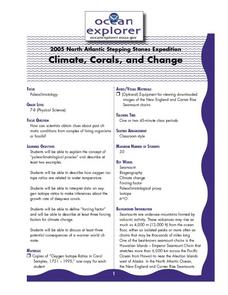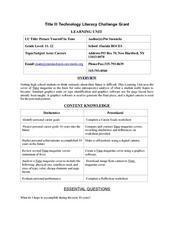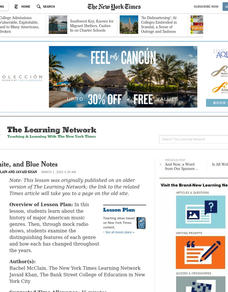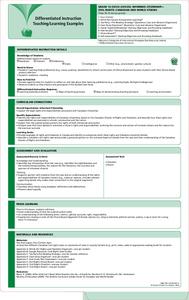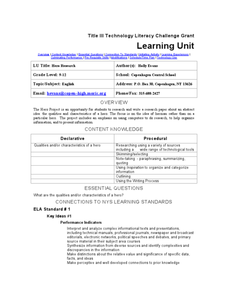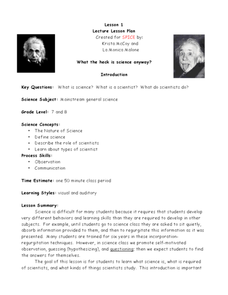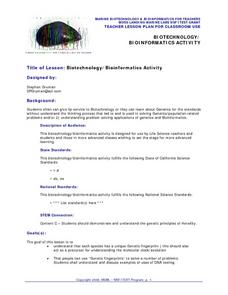Curated OER
Trekking to Timbuktu: Mansa Musa Takes a Trip - Student Version
Eleventh graders identify Mansa Musa and discuss his pilgrimage, explain how he related to leaders in the East, and describe decisions he made about his homeland. They discuss changes brought about in Mali as a result of his pilgrimage.
Curated OER
ESL Class Identity
Students work together to identify and research the country and culture of origin for each member of a group in a new ESL class. They organize the researched information in a poster and present their findings to the class.
Curated OER
Volcanoes: Mount Vesuvius
Students explain how volcanoes form. In this earth science lesson, students identify the different types of volcanoes. They create brochures about Mt. Vesuvius before and after the eruption.
Curated OER
Portrait Detectives
Students distinguish portraits from other forms of art and develop their own criteria for analyzing portraits. They discuss what is unique about a portrait, why artists create portraits, and the style of portraits.
Curated OER
Water Around Us
Third graders learn the effects of temperature on the states of water. Then students create paper snowflakes. Finally students complete a computer project with software which teaches the different states of water.
Curated OER
Climate, Corals, and Change
Students examine oxygen isotope ratios and how they are related to water temperature. They also identify three forcing factor changes for climate change.
Curated OER
Just Jelly
Students identify common gelatinous zooplankton in the Canada Basin and their ecological role. They compare and contrast feeding strategies of at least three different types of gelatinous zooplankton.
Curated OER
Students in Article Writing Shocker!
Students examine newspapers to identify the most interesting stories. They discuss the purpose of a headline and complete a worksheet. They write a paper on the differences of writing for different types of publications.
Curated OER
Post-War Japan
Students research the conditions of post-war Japan. In groups, they examine the plans that were put into place for the country and identify the attitude of the Allies. To end the lesson, they discuss the changes that came about in their...
Curated OER
Authors on the Internet
Fifth graders write a list of their favorite authors and illustrators before deciding on ways to learn more about them. They examine print and Internet resources as a way to answer questions they have. They complete an Author Scavenger...
Curated OER
Islam in America
Students examine the cultural and religious diversity within the United States. Using the differences, they discover they are a source of growth and change as well as conflict. They identify the changes that occur when new immigrants...
Curated OER
Orfeo: Sinfonie e Ritornelli
Students identify the dramatic expression made by performance and how it relates to the content of the story L'Orfeo. They determine the form of orchestra and each instrumental group within the orchestra for this piece.
Curated OER
Graphic Favorite Breakfast Foods
Second graders graph data based on a class survey of their favorite breakfast foods. In this graphing lesson plan, 2nd graders take a class survey of their favorite breakfast foods. Then they take that data and put it into a computer...
Curated OER
It's All Poetry to Me!
Fourth graders explore language arts by analyzing poetry styles. In this writing analysis lesson, 4th graders read several sample poems in class and identify similes, metaphors and other figurative language within them. Students analyze...
Curated OER
Picture Yourself in Time
A super lesson that integrates technology and career exploration! High schoolers use graphic organizers and brainstorming to first analyze Time Magazine covers, then they think about what they want to be doing in 10 years. They research...
Curated OER
Vocational; The World's Fashion Capitols
Young scholars research the world's top five fashion capitols, locating them on maps. In small groups, they complete fashion worksheets using information provided on information handouts. In a class discussion, students consider why...
Curated OER
Red, White, and Blue Notes
Students explore the history of major American music genres. Then, through mock radio shows, students examine the distinguishing features of each genre and how each has changed throughout the years.
Ontario
Informed Citizenship—Civil Rights
To launch a study of civil rights, class members brainstorm rules and expectations of behaviors at home, in school, in the workplace, and in sports. They then look at civil rights cases and examine the rules embedded in these cases.
Curated OER
Teaching Strategies for the Social Studies Classroom
Engage your class in a lesson that is concerned with the development of skills in the realm of teaching strategies needed for Social Studies. They will participate in delivering content using several strategies that are demonstrated by...
Curated OER
A Work Of Faith
Students study about different types of religious art; they then select representative works from different faiths to create their own exhibit. They research a specific religious art tradition and create an exhibit of works of art from...
Curated OER
Let the Good Times Roll
Learners read an online New York Times article and investigate the Mardi Gras celebration in New Orleans. They examine how Hurricane Katrina affected the celebration. They design a float that represents the Mardi Gras celebration.
Curated OER
Hero Research
Students examine and research the idea of heroism. They watch and discuss a Powerpoint presentation, conduct research, and write a research paper about the qualities and characteristics of a hero.
Curated OER
What the Heck Is Science Anyway?
Here is a 12-page outline of an introductory science lesson. The teacher lectures on what science is, the role of a scientists, different disciplines of science, and the impact of scientific discoveries. Detailed lecture notes are...
Curated OER
Biotechnology/Bioinformatics Activity
Young scholars demonstrate the genetic principles of Heredity. They discover that each species has a unique Genetic fingerprint and that people can use "Genetic fingerprints" to solve a number of problems. They discuss examples of uses...







